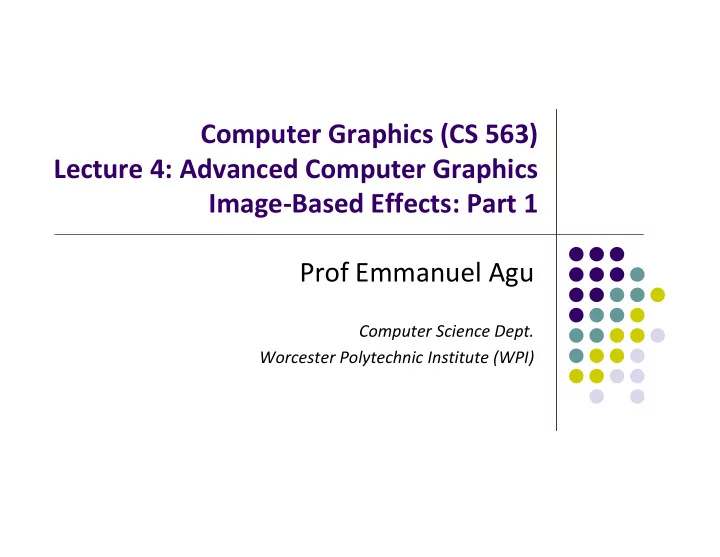

Computer Graphics (CS 563) Lecture 4: Advanced Computer Graphics Image ‐ Based Effects: Part 1 Prof Emmanuel Agu Computer Science Dept. Worcester Polytechnic Institute (WPI)
Image ‐ Based Effects Three main types of image ‐ based effects a. Image ‐ Based Rendering: Texturing to improve RT performance so that algorithms run at 30 FPS. Examples: billboards, sprites b. Image Processing Post ‐ process: Used to add effects to rendered images Examples: High Dynamic Range (HDR), tone mapping, motion blur c. Volumetric effects: atmospheric effects
Image ‐ Based Effects Image ‐ based rendering: A spectrum of IBR techniques proposed by J. Lengyel More camera control Less camera control Slower rendering Faster rendering
Fixed View Effects If viewpoint is fixed, can increase image quality Example: Few moving foreground elements in complex scene Render and store background rendering information (z ‐ buffer, color buffer, etc)
Relighting Starting from image, figure out light parameters used Re ‐ render image again with different lighting
Skyboxes Distant objects positions (mountains, sun, sky) don’t change much or suffer from parallax Skybox: use a environment map to render distant elements
Light Fields Render object from many angles, store images in data structure At run time, interpolate to render intermediate positions t v s u
Sprites, Billboards, and Impostors Sprites: Pure 2D image No warping, or projection (Example: mouse cursor) Billboards: Sprite applied to a polygon Alpha channel usually employed Uses texture mapping for acceleration Impostors: Billboards created on the fly. Can represent complex models Error metric associated w/ changed views
Layered Sprites Scene as a series of Layers Each layer has depth associated Render Back ‐ to ‐ front (avoid Z buffer) Camera movement restricted: only perpendicular scene
Billboards IBR: pre ‐ render geometry onto images/textures Map textures onto polygons, place in scene Rendering at runtime involves simple lookups, fast Orienting polygon based on View Direction Billboarding + Alpha + Animation = free forms (smoke, fire, explosions, clouds etc.) Real time cloud rendering, Mark J. Harris
Types of Billboards Three vectors of interest: up vector, normal and rotation vector (perp to up and normal) Screen Aligned Billboard: Image always parallel to screen with constant up vector Up vector = camera’s up vector
World Aligned Billboard Rendered object usually has orientation in space Use object’s up vector to orient billboard For small sprites, just align with view plane Otherwise orient with viewer position
Axial Billboards Cylindrical Symmetry ( trees, laser beams etc) Does not face straight ‐ on towards viewer Rotate around some world space axis, align to face user as much as possible Up vector fixed, view point direction is adjustable vector Tree example Single billboard v/s solid surface tree Up vector along tree trunk
Particle Systems Set of separate small objects set into motion using an algorithm Method of animation – not rendering Simulating Fire, smoke, explosions, water flow, trees, galaxies Representation – Points, lines … Can be billboards too Idea: controls for creating, moving, changing and deleting particles http://en.wikipedia.org/wiki/Particle_system
Imposters Created on fly Render a complex object into image texture Texture mapped onto Billboard Can reuse imposter for a few frames to boost performance before update
Why Create Imposters? Fast to draw Closely resemble the object Reuse for several viewpoints located close together Best for static and distant objects Movement of object diminishes with distance from viewer Overcome low LOD constraints, since a high quality imposter can be created
Imposters No Impostors Impostors Made Easy – William Damon, Intel With Impostors
Billboard Clouds Billboard Clouds , Decoret, Durand et al [SIGGRAPH‘03] Render complex mesh onto cloud of billboards Billboard inclined at different viewpoints Models with tens of thousands of trianges can be represented convincingly with less than 100 textured billboards
Depth Sprite aka Nailboard Give depth to image ! Each texel as RGB Δ ‐ Δ (transparency) is depth parameter Set Δ based on depth of actual geometry Superior to imposters because better visibility when penetrate closeby objects Accuracy varies with no. of bits to represent Δ 2 bits 4 bits 8 bits http://zeus.gup.uni-linz.ac.at/~ gs/research/nailbord/
IBR: Pros and Cons Pros Simplifies computation of complex scenes Rendering cost independent of scene complexity Cons Static scene geometry Fixed lighting Fixed look ‐ from or look ‐ at point
References Kutulakos K, CSC 2530H: Visual Modeling, course slides UIUC CS 319, Advanced Computer Graphics Course slides David Luebke, CS 446, U. of Virginia, slides Chapter 2 of RT Rendering Suman Nadella, CS 563 slides, Spring 2005
Recommend
More recommend